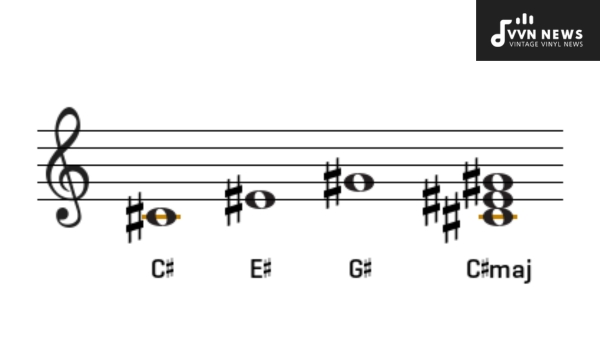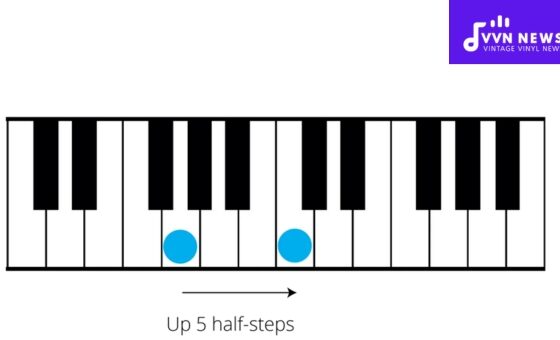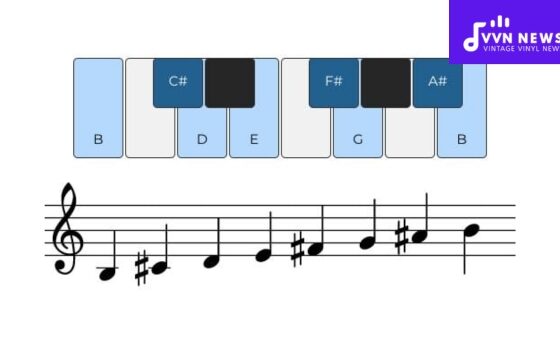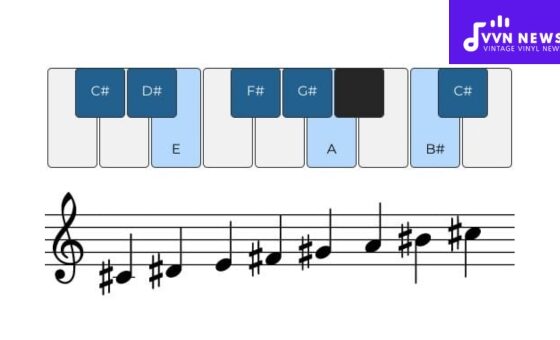There’s something undeniably magical about exploring the world of music theory. It can be fascinating, complex, and rewarding all at the same time.
Today, our focus will be squarely on one such aspect: the C Sharp Major Triad. This triad, with its full-bodied sonorous quality and unmistakable timbre, is a key component in the repertoire of any aspiring or accomplished musician.
If you’ve ever found yourself wondering about the anatomy of this unique triad or how to create it on your favorite instrument, then you’ve come to the right place.
I’ll break it down into easily digestible chunks that will provide clarity while also fostering your understanding of its role in creating harmonious soundscapes.
Think of it as your guide to mastering this elegant and robust tonality.
Why is C Sharp Major Triad Important?
The C Sharp Major Triad holds significant importance in the world of music. Its significance can greatly enhance your musical compositions, improvisations, and overall recognition of harmony. Here are a few reasons why the C Sharp Major Triad is important:
- Key center: The C Sharp Major Triad serves as the key center in the key of C# major. It provides a stable and tonal foundation for compositions in this key.
- Tonal structure: The C Sharp Major Triad consists of the root note (C#), major third (E#), and perfect fifth (G#). These three notes create a strong and distinctive tonal structure that is easily recognizable.
- Harmonic stability: The C Sharp Major Triad offers stability when used in chord progressions. Its root note acts as a solid anchor while the major third and perfect fifth contribute to its harmonically pleasing sound.
- Building block for chords: The C Sharp Major Triad serves as a foundation for building more complex chords within the key of C# major. By adding additional notes, such as sevenths or ninths, you can create rich and colorful harmonies.
- Melodic usage: The notes of the C Sharp Major Triad can be used melodically to create catchy hooks or memorable melodies within compositions. They offer a sense of resolution when returning to the root note.
- Transposition: The construction and sound characteristics of the C Sharp Major Triad enables you to transpose its pattern to different keys efficiently. This skill is essential for musicians who need to play or compose in various musical contexts.
The importance of the C Sharp Major Triad lies in its role as a fundamental building block for music in the key of C# major, its harmonic stability, melodic usage, and its transpositional capabilities.
Also Read: C Sharp Major Pentatonic Scale [Crisp & Clear Tones For Your Music]
Construction of C Sharp Major Triad

The C Sharp Major Triad is constructed by taking the root note (C#) and adding the major third (E#) and perfect fifth (G#) above it. Here is a breakdown of the construction:
- Start with the root note: The C Sharp Major Triad begins with the root note, which is C#. This serves as the foundation for the triad.
- Add the major third: The major third in a triad is two whole steps above the root note. In this case, count up two whole steps from C# to find E#. E# may seem like an uncommon note, but it is enharmonically equivalent to F.
- Include the perfect fifth: The perfect fifth is found three and a half steps above the root note. From C#, count up three whole steps plus a half step to arrive at G#. G# is also enharmonically equivalent to Ab.
Once you have these three notes – C#, E#, and G#, played together simultaneously, you have successfully constructed a C Sharp Major Triad.
It’s important to note that each component plays a crucial role in shaping the sound of the chord.
The root note gives it stability and defines its tonal center, while the major third adds brightness and sweetness to its character.
The perfect fifth adds richness and helps create a sense of resolution when returning to the root note.
Understanding how triads are constructed is essential for any musician looking to expand their harmony and composition. By grasping these concepts, you can unlock countless creative possibilities within your music.
Inversions of C Sharp Major Triad
Now that we have explored the importance of the C Sharp Major Triad, let’s dive into its inversions. An inversion occurs when one of the notes of a triad is placed in the lowest position, altering the chord’s structure while maintaining the same three notes.
Inversions can add variety and depth to your compositions. Here are the three inversions of the C Sharp Major Triad:
- Root Position: In the root position, the root note (C#) is at the bottom, followed by the major third (E#), and finally, the perfect fifth (G#). This is considered the standard or default form of a triad.
- First Inversion: The first inversion involves moving the lowest note, which is now E#, to the top, creating an inverted chord structure. The order of notes becomes G#, C#, and E#. As a result, the major third becomes the bass note.
- Second Inversion: Continuing from the first inversion, for this inversion, we move G# to be in front of C#. The order of notes now becomes C#, G#, and E#. Here, we have inverted both the root note and major third positions.
It’s important to mention that all inversions are part of the same triad; only their structural arrangement changes.
Each inversion produces a unique harmonic quality and can be used strategically to bring different moods or emphasize certain melodies within your music.
Also Read: A Sharp Minor Pentatonic Scale [Unique Harmonic Possibilities]
C Sharp Flat Minor’s Inversions on Guitar & Piano

In music theory, inversions refer to different arrangements of the same triad. The C Sharp Flat Minor Triad, also known as C♯m/Dbm, consists of the notes C♯, E, and G♭.
The inversions of this triad on both guitar and piano will allow you to explore different voicings and create unique sounds in your compositions. Let’s break down the inversions step by step:
Inversions on Guitar
On guitar, you can play the C Sharp Flat Minor Triad inversions using various chord shapes across the fretboard. Here is a breakdown of each inversion:
- Root position (C♯m): The root position is played by placing your index finger on the 4th fret of the A string (root note C♯), your middle finger on the 5th fret of the D string (E), and your ring finger on the 6th fret of the G string (G♭). Strum only these three strings.
- First inversion (E major): To play the first inversion, move your index finger to the 4th fret of the E string (E), your middle finger to the 5th fret of the A string (G♭), and your ring finger to the 6th fret of D string (C♯). Strum from low E to high E, skipping over B and G strings.
- Second inversion (G♭ major): The second inversion requires you to place your index finger on the 4th fret of the low E string for the G♭ note, your middle finger on the 5th fret of A string for C# note, and your ring finger on the 6th frett of D string for E note. Strum from low E to high E, excluding G and B strings.
Inversions on Piano
On the piano, you can explore the inversions of the C Sharp Flat Minor Triad by rearranging the order of the notes. Here is a breakdown of each inversion:
- Root position (C♯m): In the root position, place your right hand’s thumb on C♯, your middle finger on E, and your pinky finger on G♭. Play these three notes simultaneously.
- First inversion (E major): For the first inversion, place your thumb on the E note (the root note in this inversion), your index finger on G♭ , and your middle finger on C♯. Play all three notes together.
- Second inversion (G♭ major): In the second inversion, place your thumb on G♭, index finger on C♯ (the root note in this inversion), and middle finger on E. Simultaneously press down these notes to play the second inversion.
These inversions will allow you to create unique chord progressions and add variety to your compositions and improvisations using the C Sharp Flat Minor Triad.
Also Read: G Sharp Minor Pentatonic Scale [Add Dimension To Your Music]
Triads in C Sharp Major Scale
When exploring the C Sharp Major scale, it is essential to understand the triads formed within this scale. A triad is a three-note chord consisting of a root, third, and fifth.
Let’s take a closer look at each triad within the C Sharp Major scale and its unique characteristics:
1. C Sharp Major Triad (C# – E# – G#)
The C Sharp Major triad consists of the notes C#, E#, and G#. It is built on the first degree of the C Sharp Major scale and represents the tonic or home chord.
This triad has a bright and uplifting sound, making it ideal for establishing a sense of stability within compositions.
2. D Sharp Minor Triad (D# – F# – A#)
The D Sharp Minor triad consists of the notes D#, F#, and A#. It is built on the second degree of the C Sharp Major scale.
This minor triad creates a melancholic and introspective mood, often used in emotional passages or when transitioning to different sections within a composition.
3. E Sharp Minor Triad (E# – G# – B#)
The E Sharp Minor triad consists of the notes E#, G#, and B#. It is built on the third degree of the C Sharp Major scale.
While E# may seem uncommon due to enharmonic equivalents like F or G♭, it functions as a theoretical concept in music theory. The E Sharp Minor triad has an ambiguous quality, possessing both dark and bright characteristics.
4. F Sharp Minor Triad (F# – A – C#)
The F Sharp Minor triad consists of the notes F#, A, and C#. It is built on the fourth degree of the C Sharp Major scale.
This minor triad imparts a sense of longing or tension, often used in emotional or dramatic musical sections.
5. G Sharp Major Triad (G# – B# – D#)
The G Sharp Major triad consists of the notes G#, B#, and D#. It is built on the fifth degree of the C Sharp Major scale. This major triad has a bright and uplifting sound, making it versatile for various genres and styles.
6. A Sharp Minor Triad (A# – C# – E#)
The A Sharp Minor triad consists of the notes A#, C#, and E#. It is built on the sixth degree of the C Sharp Major scale.
Similar to other minor triads, this chord conveys a melancholic tone and is commonly used in minor key compositions.
7. B Flat Diminished Triad (B♭ – D♭ – F)
The B Flat Diminished triad consists of the notes B♭, D♭, and F. It is built on the seventh degree of the C Sharp Major scale.
This diminished triad has a tense and unresolved sound due to its dissonant quality. It often acts as a transitional chord in musical progressions.
The triads within the C Sharp Major scale allow musicians to construct harmonically rich melodies, create chord progressions, and explore musical possibilities within this key signature.
Memorizing these triads will greatly assist in composition, improvisation, and overall knowledge of music theory.
Also Read: D Sharp Minor Pentatonic Scale [Inject Drama Into Your Melodies]
Practicing C Sharp Major Triad on Instruments

Practicing the C Sharp Major Triad on your instrument of choice is an important step in developing your musical skills and Knowledge.
Here are some useful tips and techniques to help you practice the C Sharp Major Triad efficiently:
Piano/Keyboard:
- Start by familiarizing yourself with the notes of the C# Major Triad: C#, E#, and G#. Visualize their positions on the piano keys.
- Begin by playing the triad in its root position, where C# is the lowest note. Practice playing it ascending and descending, smoothly and evenly.
- Once you are comfortable with the root position, explore inversions of the triad. Inversion means changing the order of notes while keeping the same triadic structure.
- Practice each inversion separately, paying attention to hand placement and fingerings for smooth transitions between chords.
- Gradually increase your speed as you become more proficient. Use a metronome to maintain a steady tempo and challenge yourself to play at different speeds.
- Incorporate different rhythms into your practice routine to improve your sense of timing and syncopation.
Guitar:
- Locate the three notes that make up the C Sharp Major Triad – C#, E#, and G# – on various parts of the guitar neck using different chord shapes and positions.
- Practice playing each note individually, ensuring clear articulation and proper finger placement for optimal tone production.
- Experiment with different fingerings and voicings of the triad across different strings and frets for variation in sound and technique.
- Once comfortable with one position, try moving between different positions smoothly while maintaining a consistent rhythm.
- Practice strumming or arpeggiating the triad using different patterns, both ascending and descending, to develop dexterity and musicality.
- As you progress, challenge yourself to play the triad in different keys and explore its application within chord progressions, scales, or improvisations.
Remember to practice slowly and carefully at first, gradually increasing the tempo as you become more comfortable. Consistent practice and attention to proper technique will allow you to internalize the C Sharp Major Triad and incorporate it fluidly into your musical repertoire.
Common C Sharp Major Triad Progressions
The Common chord progressions using the C Sharp Major Triad is essential for musicians looking to create harmonically rich and engaging compositions.
These progressions provide a framework for creating melodies and building musical tension and resolution. Let’s explore some of the most common C Sharp Major Triad progressions:
- I – IV – V: This progression is widely used in many musical genres. In the key of C# major, this would correspond to the chords C# major, F# major, and G# major. It creates a sense of stability (tonic), followed by a subtle tension (subdominant), and finally resolves to the dominant chord.
- I – vi – IV – V: Also known as the “50s progression,” this sequence has been used in countless popular songs. In C# major, this progression would consist of C# major, A# minor, F# major, and G# major. It offers a nostalgic and uplifting sound that is instantly recognizable.
- I – vi – IV – V7: This variation of the previous progression adds a dominant seventh chord to the final chord (G#7). The dominant seventh creates a stronger sense of resolution when returning to the tonic chord (C# major). It is commonly heard in blues and jazz compositions.
- ii – V – I: This progression is known as the “jazz turnaround” or “2-5-1.” In C# major, it includes D# minor, G# major, and C# major. It creates a smooth harmonic movement that leads back to the tonic chord.
- IV – I: This simple yet effective progression emphasizes the subdominant-to-tonic relationship. In C# major, it consists of F# major followed by C# major.
- V/vi – vi: This progression introduces a secondary dominant chord (G# major) to enhance the resolution to the vi chord (A# minor). It creates a subtle tension before resolving to a comforting sound.
- I – iii – vi – IV: This progression offers a more subdued and introspective sound. In C# major, it includes the chords C# major, E# minor, A# minor, and F# major. It is commonly found in pop ballads and emotional compositions.
These progressions are not limited to these keys or musical genres. Experimenting with variations and extensions of these progressions can help you create unique and captivating musical compositions.
Popular Songs of The C Sharp Major Triad

The C Sharp Major Triad can be found in countless popular songs across various genres. Its distinct sound and harmonic stability make it a favorite among songwriters and composers.
Here are a few examples of popular songs that prominently feature the C Sharp Major Triad:
- “Someone Like You” by Adele: This emotional ballad showcases the C Sharp Major Triad throughout its chord progressions. The triad creates a sense of longing and resolution, perfectly complementing Adele’s powerful vocals.
- “All of Me” by John Legend: The opening chords of this heartfelt ballad consist of the C Sharp Major Triad, setting the emotional tone for the rest of the song. The triad provides a solid foundation for Legend’s soulful voice and piano accompaniment.
- “Heal the World” by Michael Jackson: The C Sharp Major Triad can be heard in the uplifting chorus of this iconic song. Its inclusion adds to the optimism and hope conveyed through Jackson’s powerful lyrics and vocal performance.
- “Thinking Out Loud” by Ed Sheeran: This romantic ballad features the C Sharp Major Triad prominently in its chord progressions. It contributes to Sheeran’s signature warm and melodic sound, creating a memorable tune loved by many.
- “Sweet Child O’ Mine” by Guns N’ Roses: This rock anthem utilizes the C Sharp Major Triad in its powerful guitar riffs and chord progressions. The triads add intensity and energy to the song, becoming one of its defining characteristics.
- “Viva la Vida” by Coldplay: This uplifting anthem is built upon an arpeggiated version of the C Sharp Major Triad played on strings throughout the song. It creates a majestic sound that perfectly matches Coldplay’s anthemic style.
- “I Want to Hold Your Hand” by The Beatles: The C Sharp Major Triad can be heard in the iconic opening guitar riff of this timeless song. Its inclusion sets the tone for the infectious melody and harmonies that follow.
The C Sharp Major Triad may appear in different inversions or variations within these songs. It is always interesting to analyze how songwriters and composers use this triad to create unique and memorable musical moments.
Also Read: G Sharp Diminished Triad [Explore Unique Guitar Chords]
FAQs about the C Sharp Major Triad
What are the notes of the C Sharp Major Triad?
The C Sharp Major Triad consists of the notes C#, E#, and G#.
How is a triad constructed?
A triad is constructed by combining the root note, major third, and perfect fifth of a given key or chord.
Can the C Sharp Major Triad be inverted?
Yes, the C Sharp Major Triad can be inverted by rearranging the positions of its notes. Inversion provides different harmonic possibilities and voicings.
How can I practice playing the C Sharp Major Triad on guitar or piano?
On guitar, you can play the C Sharp Major Triad by placing your index finger on the 4th fret of the A string (C#), your middle finger on the 6th fret of the D string (E#), and your ring finger on 6th fret G string (G#). On the piano, you can play it by simultaneously pressing down the C# key, E# key, and the G# key.
Are there any popular songs that utilize the C Sharp Major Triad?
Yes! Some well-known songs that prominently feature the sound of the C Sharp Major Triad include “Let It Be” by The Beatles and “Rolling in the Deep” by Adele.
Conclusion
The C Sharp Major Triad is a foundational element in music theory, offering stability and tonal structure.
Its construction, sound characteristics, and applications can greatly enhance your musical compositions and improvisations.
Whether you are a musician or simply curious about music theory, incorporating the C Sharp Major Triad into your musical repertoire will open up endless possibilities for creating harmonically rich melodies.
So embrace the world of the C Sharp Major Triad and let its tones uplift your musical creations!








